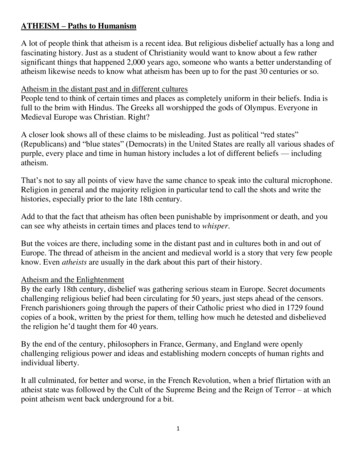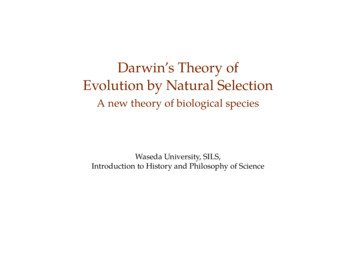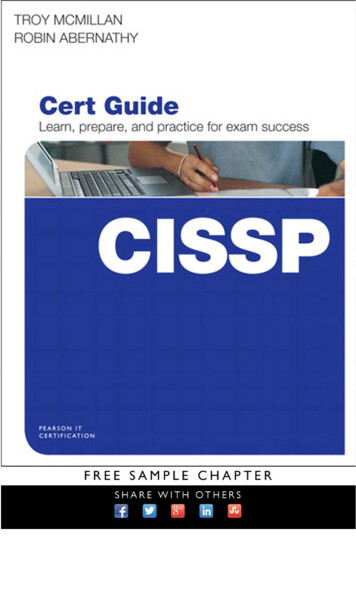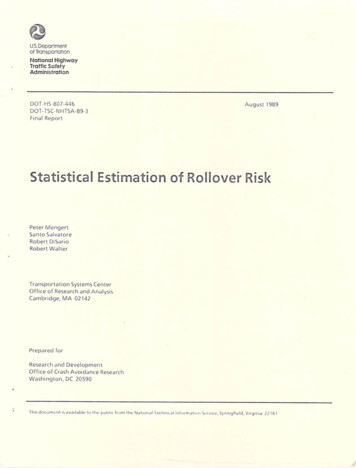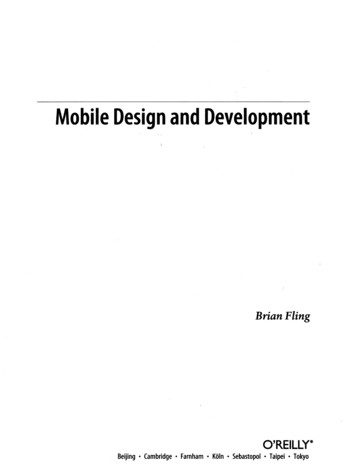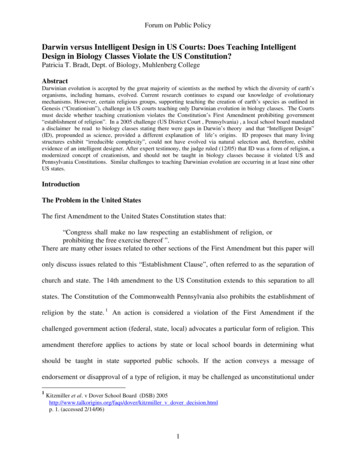
Transcription
Forum on Public PolicyDarwin versus Intelligent Design in US Courts: Does Teaching IntelligentDesign in Biology Classes Violate the US Constitution?Patricia T. Bradt, Dept. of Biology, Muhlenberg CollegeAbstractDarwinian evolution is accepted by the great majority of scientists as the method by which the diversity of earth’sorganisms, including humans, evolved. Current research continues to expand our knowledge of evolutionarymechanisms. However, certain religious groups, supporting teaching the creation of earth’s species as outlined inGenesis (“Creationism”), challenge in US courts teaching only Darwinian evolution in biology classes. The Courtsmust decide whether teaching creationism violates the Constitution’s First Amendment prohibiting government“establishment of religion”. In a 2005 challenge (US District Court , Pennsylvania) , a local school board mandateda disclaimer be read to biology classes stating there were gaps in Darwin’s theory and that “Intelligent Design”(ID), propounded as science, provided a different explanation of life’s origins. ID proposes that many livingstructures exhibit “irreducible complexity”, could not have evolved via natural selection and, therefore, exhibitevidence of an intelligent designer. After expert testimony, the judge ruled (12/05) that ID was a form of religion, amodernized concept of creationism, and should not be taught in biology classes because it violated US andPennsylvania Constitutions. Similar challenges to teaching Darwinian evolution are occurring in at least nine otherUS states.IntroductionThe Problem in the United StatesThe first Amendment to the United States Constitution states that:“Congress shall make no law respecting an establishment of religion, orprohibiting the free exercise thereof ”.There are many other issues related to other sections of the First Amendment but this paper willonly discuss issues related to this “Establishment Clause”, often referred to as the separation ofchurch and state. The 14th amendment to the US Constitution extends to this separation to allstates. The Constitution of the Commonwealth Pennsylvania also prohibits the establishment ofreligion by the state. 1 An action is considered a violation of the First Amendment if thechallenged government action (federal, state, local) advocates a particular form of religion. Thisamendment therefore applies to actions by state or local school boards in determining whatshould be taught in state supported public schools. If the action conveys a message ofendorsement or disapproval of a type of religion, it may be challenged as unconstitutional under1Kitzmiller et al. v Dover School Board (DSB) er v dover decision.htmlp. 1. (accessed 2/14/06)1
Forum on Public Policythe “Establishment Clause” of the First Amendment. The issue is then decided in US FederalCourts (94 District Courts, 12 Regional Courts of Appeals, One Supreme Court) because thesecourts resolve cases related to constitutional issues.Currently in the United States, Fundamentalist Christians and other antievolutionists want“Intelligent Design” (ID) taught in high school biology classes to 15 and 16 year olds, as analternative to the theory of evolution. This theory of evolution was first proposed by CharlesDarwin in 1859 and has been greatly expanded and revised by the subsequent 145 years ofscientific research.As political conservatives have gained more public support in the US, and as states are requiredto have educational standards that include science, there are more challenges to the teaching ofevolution in public schools. Proposals, of various forms, but hostile to teaching evolution, arebeing considered in at least nine US states.Opposition to teaching biological evolution grew out of the religious tradition, ChristianFundamentalism. This fundamentalism began in the US in the 19th century in response to socialchange, new religious thought and the publication of Darwin’s Origin of the Species . 2 Theseopponents of evolution considered these developments as contrary to the teachings of the Bibleand objected to Darwin’s theory of evolution as a scientific explanation for the diversity ofspecies. 3 In response to an upsurge of the fundamentalist religious movement in the 1920’s,religiously motivated groups lobbied state legislatures to adopt laws to prohibit public schoolsfrom teaching evolution. This prohibition culminated in the Scopes (“Monkey”) trial in 1927 in23. McLean v. Arkansas Board of Education. 1982. Decision by U.S. District CourtJudge William R. Overton. 1/5/82. html. (accessed 3/15/06)Scott, E. C. 2004. Evolution vs. Creationism. An introduction. Greenwood Press Westport,CT.2
Forum on Public PolicyTennessee when a teacher was criminally prosecuted for teaching evolution in defiance of thestate law prohibiting such teachings. 4Most states now have state educational standards for kindergarten through twelfth grade.These standards are established by state educational boards. In Pennsylvania, for example, theAcademic Standards for Science and Technology require students to acquire knowledge andskills needed to explain the mechanisms of the theory of evolution.5However there are at least17,000 local school boards in the US and these boards can decide how state standards areimplemented in the local public schools6. According to the Thomas B. Fordham Institute,Pennsylvania received a “C” for it’s science standards, but a “sound” for the teaching ofevolution. 7Why is teaching of biological evolution such a controversial subject in US?From Table 1 it is obvious that Americans are divided about the teaching of evolution inpublic schools. Because such a large number of US citizens do not accept or understandevolution, it is often just not taught in biology, unless mandated by state science standards. Forexample, because evolution is so controversial many high school teachers avoided the subjectcompletely in the ‘50’s and ‘60’s or only made brief reference to it. 8 In addition there isconsiderable confusion among the American public caused by the terms creationism andevolution. Given the lack of understanding and acceptance of evolution, it is not surprising thatsuch controversies have arisen concerning teaching evolution in science classes in public schools.4Scopes Trial 1927. http;//themonkeytrial.com (accessed 5/10/06)Kitzmiller et al. v DSB. p 2.6Gross, P. R., U. Goodenough, L. S. Lerner, S. Haack, M. Schwartz, R. Schwartzand C. E. Finn. 2005. The State of State Science Standards 2005. Thomas B.Fordham Institute, Washington, D.C. (accessed cation/publication.cfm?id 527ibid8Miller, K. 1999. Finding Darwin’s God. HarperCollins, New York. p1053
Forum on Public PolicyThe teaching of evolution has been labeled a “national educational crisis”. 9 Even many collegestudents in the US today have not learned about evolution in high school, therefore do notunderstand it’s premises. So evolution is also being challenged occasionally at the college anduniversity levels. 10 The interim president of Cornell University (Ithaca, NY), Hunter RawlingsIII, considered the teaching of ID such an important issue that he devoted his entire “State of theUniversity’ address to it, with much emphasis on freedom of thought. President Rawlings stated“The issue in question is the challenge to science posed by religiously-based opposition toevolution, described, in its current form, as “intelligent design”. 11 He called ID a “religious beliefmasquerading as a secular idea”. 12Scientific illiteracy is a growing concern among scientists in the US.13According toevolutionary biologist Massimo Pigliucci, “more scientists ought to face the realities of publicmisunderstanding of science” 14 .Another important question is: does the general public really understand what a scientifictheory is? “The word ‘theory’ is the most misunderstood word in science”. 15 When evolution isdeemed a theory, does the public understand what this means? To the general public “theory”implies a “guess” or a “hunch”. However to scientists, this is not the meaning. The NationalAcademy of Sciences defines theory as “a well substantiated explanation of some aspect of thenatural world that can incorporate facts, laws, inferences, and test hypotheses.” 169Nehm, R. H. 2006. “Faith-based evolution education?” BioScience 56 (8): 638-639Holden, C. 2006. “Darwin’s Place On Campus Is Secure – But Not Supreme.”Science 311: 769-771.11Rawlings, H. R. III. 2005. State of the University. Address to Cornell Board of Trustees and the UniversityCouncil. 10/21/0512. ibid.13Gross, L. 2006. Scientific illiteracy and the partisan takeover of biology. PloSBiol 4(5): e16714Pigliucci, M. 2006. Have we solved Darwin’s Dilemma? American Scientist 94:272-274.15Scott, E. C. 2004. Evolution vs. Creationism. p. 1416National Academy of Sciences (NAS). 1998. Teaching about Evolution and the Nature of Science, NationalAcademy Press, Washington, DC. p 7.104
Forum on Public PolicyTable 1US Public Opinion PollsTeaching Evolution and Creationism in Public SchoolsQuestionPercentageofUSSourcepopulationLife on earth existed in present form since42Pew Forum on Religion andPublic Life 8/30/05 abeginning of timeWhite evangelical protestants70Pew Forum 2005Mainline protestants32Pew Forum 2005White Roman Catholics31Pew Forum 2005Life evolved over time48Pew Forum 2005Evolution guided by18Pew Forum 2005Evolution via natural selection26Pew Forum 2005Don’t know how life evolved4Pew Forum 2005Don’t know about evolution of life10Pew Forum 2005Open to teaching creationism with evolution64Pew Forum 2005Supreme being5
Forum on Public PolicyReplace evolution with teaching creationism38Pew Forum 2005Students reporting being uncomfortable with6Pew Forum 200541Pew Forum 200521Pew Forum 200528Pew Forum 2005subject of evolution in schoolParents should be primarily responsible forhow evolution taughtSchool boards should be primarily responsiblefor how evolution taughtScientists should be primarily responsible forhow evolution taughtReject theory of evolution, God created51Collins, NY Times 11/7/05 bhumans in present form(CBS News Poll 10/05) ba. Pew Forum on Religion and Public Life. 2005. Public Divided on Origins of Life. WashingtonDC. 8/30/05 http://pewforum.org/surveys/origins/#3 (accessed 3/3/06)b. Collins, G. 2005. “An Evolutionist’s Evolution.” New York Times. 11/7/05A theory is an explanation based on observation, reasoning, testing and support from manyscientists. Therefore, scientists do not mean an unsubstantiated idea or hunch, but an idea that ishighly likely and well supported by experimental and statistical evidence. A theory. as discussedby scientists, is different from the general public’s understanding. Consequently, the averageAmerican does not understand the meaning of the theory of evolution.The subject of the origin of life is even more controversial than the study of evolution, thathappened once life arrived on Earth. The origin of life is within province of biology, but6
Forum on Public Policybiologists do not consider life’s origins as part of evolutionary theory. 17 Evolution focuses on theevolution of life forms once life had originated 18Another factor contributing to American’s misunderstanding of evolutionary theory is thetreatment of the subject by the press. Rosenhouse, J. and G. Branch discuss the media (television,newspapers, magazines) coverage of the Dover trial and conclude that often reporters, with noscientific training, distorted the science, contributing further to public misunderstanding. 19Antievolutionists encourage journalists to present both sides of the issue. This may lead tomisconceptions on the part of the public that scientists are equally divided on the issue, when, infact, the great majority of scientists enthusiastically accept evolution. 20What are the Legal Challenges to Teaching Creationism, Scientific Creationism andCreation Science?The teaching of creationism, the literal interpretation of the creation story from Genesis I, hascreated controversy since the Scopes Trial (Scopes v. Tennessee, Table 2) when a teacher wascriminally prosecuted and found guilty of teaching evolution in his class when state law forbade it.This trial is the subject of the play Inherit the Wind, first performed in 1955.21Since then therehave been many challenges to teaching evolution. The court system has been most vigilant inmonitoring schools compliance with the “Establishment Clause” because the classroom should not17Matsumura, M. 2001. Eight major court decisions against teaching creationism as science. National Council onScience Education. Oakland, CA. 2 pp.www.ncseweb.org/resources/articles/3747 8 major court decisions against 2 15 218ibid.19Rosenhouse, J. and G. Branch. 2006. Media coverage of “Intelligent Design”.BioScience 56 (3): 247-25220ibid21Lawrence, J. and R. E. Lee 1955. Inherit the Wind. Bantam Books, New York.7
Forum on Public Policybe used to advance religious beliefs that may conflict with students’ family beliefs. 22After Epperson v. Arkansas in 1968 (Table 2) when the US Supreme Court declared theteaching of Creationism was unconstitutional, evolution opponents proposed a “balancedtreatment” for both evolution and the biblical version of creation, “Creationism”. 23this tactic was also declared a violation of the “Establishment Clause”.24However,Then evolutionopponents proposed scientific sounding subjects such as “Creation Science” and “ScientificCreationism” be taught as alternatives to evolution . 25 These opponents claimed that the creationstory and the origins of man as written in the Book of Genesis, were supported by scientific data.22Edwards et al. v. Aguillard et al. 1987. No. aguillard.html (accessed 2/20/0623Kitzmiller et al. v. DSB. P. 824Daniels v. Waters ml (accessed 5/5/0625McLean v Arkansas Bd. Education 1982 . kansas.html (accessed 3/15/068
Forum on Public PolicyTable 2Relevant Court DecisionsConstitutionality of Teaching Creationism as ScienceDATENAME OF CASERESULTS1927Scopes v. Tennesseecriminal prosecution of teacher for teaching evolution againstTennessee law http://www.themonkeytrial.com/1968Epperson v. ArkansasUS Supreme Court declared unconstitutional Arkansas law tClause”of1stConstitutional v-arkansas.html1975Daniel v Waters - US Courtof Appeals6th Circuit(TN, KY, OH)Tennessee law requiring “balanced treatment” of dment“Establishment” ers.html1982McLean v. Arkansas BoardFederal District Court declared unconstitutional Arkansas lawOf Educationrequiring creation science be taught with evolution - creation sciencewas merely biblical creationism in a new guise - used “Lemon Test”* toevaluate the constitutionality of as.html1987Edwards v. AguillardUS Supreme Court ruled unconstitutional Louisiana law requiringNo. 85-1513“balanced” treatment of creation science with evolution - Stated sciencecurriculum restructured to conform to a particular religious viewpoint9
Forum on Public Policy–Decision made a national prohibition against teachingcreation science in US public schoolsthe challenged law failed on all 3 prongs of “Lemon guillard.html2005Kitzmiller et al. v. DoverFederal District (Pennsylvania) Court ruled ID wasArea School District et al.religion, not science, and should not be taught inhigh school biology classesDecision based on previous court decisions and the “Lemon iller v dover decision.htmlHowever, this approach was also labeled a violation of the “Establishment Clause” (Table 2 McLean v. Arkansas Board of Education 1982 ). 26 The Court stated that creation science restedon a “contrived dualism” that recognized only two possible explanations for life, the scientifictheory of evolution and biblical creationism. According to this court decision, evolution andcreationism were treated as mutually exclusive so that “one must accept the literal interpretationof Genesis or else believe in the godless system of evolution”. 27Creation-science includes the scientific evidence and related inferences thatindicate:1) Sudden creation of the universe, energy, and life from nothing;2627McLean v Arkansas Bd. Education 1982ibid10
Forum on Public Policy2) The insufficiency of mutation and natural selection in bringing aboutdevelopment of all living kinds from a single organism;3) Changes only within fixed limits of originally created kinds of plants andanimals;4) Separate ancestry for man and apes;5) Explanation of the earth's geology by catastrophism, including theOccurrence of a worldwide flood;6) A relatively recent inception of the earth and living kinds. 28In Louisiana in 1987 there was another attempt at teaching the “balanced approach” byforbidding the teaching of evolution unless accompanied also by teaching creation science. 29 TheUS Supreme Court ruled this act also violated the “Establishment Clause” (Table2). The decisionincluded a national prohibition against teaching creationism as science and, therefore, ended thehopes of antievolutionists to force public schools to teach any form of creationism30(Edwards v.Aguillard 1987 – Table 2). Neither Epperson v Arkansas nor Edwards v. Aguillard had anyprohibitions against teaching creationism in religion or literature classes, the laws applied only toscience classes.What is the History of Intelligent Design?28ibidMasci, D. 2005. From Darwin to Dover: An overview of important cases in the evolutiondebate. Pew Forum on Religion and Public Life. Washington, DC. 5 pp. (accessed 4/10/06)30Edwards et al. v. Aguillard et al. 19872911
Forum on Public PolicyFollowing the Edwards decision (Table 2), opponents of evolution chose the term “intelligentdesign” instead of “creationism”.31The term “intelligent design” first appeared in the firstedition (1989) of the high school biology text, Of Pandas and People (Pandas) by P. David andD. Kenyon. 32 This text is considered to be the first intelligent design book. 33ID proponents think living organisms are too complex to be explained by any natural, random,mindless process such as natural selection. Complex organisms and their biochemical andstructural components exhibit a design that can only be accounted for by invoking a very, verysmart designer. However, ID maintains that life was created, but is generally silent about thecreator’s identity.34According to Michael Behe “Some systems seem very difficult to form bysuch successive modifications – I call them irreducibly complex” e.g if you remove one singlepart from the cell structure, the structure will no longer function.Behe, presents Darwinism with “unbridgeable chasms”.3635Irreducible complexity, statesOne biological example Behe uses isthe bacterial flagellum that contains thirty different proteins, all precisely arranged. If youremove anyone of the proteins, the flagellum will not spin.37Behe wonders how a gradualprocess of incremental improvement could build a flagellum needing all parts to function? Manybiochemical systems cannot be built by natural selection working on mutations.38Therefore“irreducible complex” cells arise like irreducible complex mousetraps, someone designs them. Adesigner might have assembled the first cell, solving the problem of “irreducible complexity”,after which evolution may have proceeded by conventional means. The apes still evolved on the31Kitzmiller et al. v. DSB. p 24Davis, P. and D, Kenyon. 1993. (5th printing 2004). Of Pandas and People. The Central Question ofBiological Origins. Foundation for Thought and Ethics, Richardson, TX.33Matzke, M. 2004. Introduction: Of Pandas and People, the foundational work of the “Intelligent Design”movement. National Center for Science Education, Oakland, CA. 1 p.34Orr, H. A. 2005. Devolution. Why intelligent design isn’t. New Yorker 5/30/0535Behe, Michael. 2002. The challenge of irreducible complexity. Natural History,April36Behe, M. 1996. Darwin’s Black Box. The Free Press. New York37Behe, M. 2002. Natural History38Orr 2005. New Yorker.3212
Forum on Public PolicyAfrican savannah, but our cells harbor micro-machines engineered by an unnamed intelligenceapproximately four billion years ago. 39ID is not the same as biblical literalism. 40 ID advocates shun the “creationism” label and donot believe the earth was created in six days, nor that earth is only 10,000 yrs old, nor that thefossil record was laid down during Noah’s flood . 41 Proponents do acknowledge someevolutionary change over time, changes may occur within a species, but evolution alone cannotaccount for the myriad of species on earth today. 42Supporters of ID include the Center for Science and Culture at the Discovery Institute(CSCDI) in Seattle, Washington. This Center “supports research by scientists and other scholarschallenging various aspects of neo-Darwinian theory”.43They have published articles and bookson ID. Members of these organizations include: Phillip Johnson, an emeritus law professor andprogram advisor, Stephen Meyer, a philosopher and program director, and Jonathan Wells,Senior Fellow, who holds Ph.D’s in both molecular biology and religious studies. The scientificleaders are Scott Minnich, microbiologist and senior fellow at CSCDI and Michael Behe, abiochemist and author of the book Darwin’s Black Box (1996). 44“Intelligent Design proponents posit that the universe, or at least components of it, have beendesigned by an ‘intelligence’. They also claim that they can empirically distinguish intelligentdesign from that produced through natural processes (such as natural selection).”form of ID came into existence after the Edwards case in 1987.4645The currentAccording to Dover trialwitness Rev. John Haught, the only theologian to testify at the trial, the argument for ID is not a39ibid.Haught, J. F. 2003. Deeper than Darwin . Westview Press, Boulder, CO. p 12541Orr 2005. New Yorker.42Scott, E. 2004 Evolution vs. Creationism p 126 – 12943Center for Science and Culture, Discovery Institute. http://www.discovery.org.csc44Behe, M. 1996. Darwin’s Black Box.45Scott, E. 2004. Evolution vs. Creationism. P. 11746Kitzmiller et al. v. DSB. p 24.4013(accessed 5/11/06)
Forum on Public Policynew scientific argument, but is rather an old religious argument for the existence of God goingback to Thomas Aquinas in the 13th century who “argued that design in nature points toward asupreme intelligence”. 47 Dr. Haught testified that Aquinas was explicit that this intelligentdesigner “everyone understands to be God.” 48Professor Haught explained that in Westernintellectual tradition, non-natural causes occupy a space reserved for ultimate religiousexplanations. 49Dr. Barbara Forrest, one of Plaintiffs’ expert witnesses, is the co-author of the bookCreationism’s Trojan Horse: the Wedge of Intelligent Design by Forrest and Paul R. Gross.where they chronicled the history of ID. 50 Her testimony provided many statements by IDleaders that revealed ID’s religious, philosophical, and culturalcontent. 51Can Science Confirm the Supernatural?Can ID be confirmed by the scientific method? If certain biological structures and functionswere designed by an unnamed intelligence, can science confirm this intelligence? Attributingunsolved problems about nature to causes and forces outside the natural world is a “sciencestopper”. 52 Due to the methods of science, once you attribute a cause to an untestablesupernatural force, the proposition cannot be proven or disproven by scientific testing. Intelligentdesign (formerly Creationism, Creation Science) proposes to change the ground rules of science47Haught, J. F. 2005. Expert testimony p 7-8.http://www2.ncseweb.org/kvd/experts/haught.pdf (accessed 4/15/06)48ibid.49. Kitzmiller et al. v. DSB. p 30.50Forrest, B. and P. R. Gross. 2004. Creationism’s Trojan Horse: the Wedge ofUniversity Press, New York.51Kitzmiller et al. v. DSB. p 2652Miller, K. 2005. expert testimony. pp f. (accessed 4/20/06)14Intelligent Design. Oxford
Forum on Public Policyto include supernatural causation. According to McLean vs. Arkansas Board of Education this isa religious concept. 53The U.S. National Academy of Sciences has stated that intelligent design "and other claims ofsupernatural intervention in the origin of life" are not science because they cannot be tested byexperiment, do not generate any predictions and propose no new hypotheses of their own. 54What is Biological Evolution?“Evolution-science” includes the scientific evidences and related inferences that indicate: (1)Emergence by naturalistic processes of the universe from disordered matter and emergence oflife from nonlife; (2) The sufficiency of mutation and natural selection in bringing aboutdevelopment of present living kinds from simple earlier kinds; (3) Emergence by mutation andnatural selection of present living kinds from simple earlier kinds; (4) Emergence of man from acommon ancestor with apes; (5) Explanation of the earth's geology and the evolutionarysequence by uniformitarianism and (6) An inception several billion years ago of the earth andsomewhat later of life. 55“The concept of biological evolution is one of the most important ideas ever generated by theapplication of scientific methods to the natural world. The evolution of all the organisms that liveon Earth today from ancestors that lived in the past is at the core of genetics, biochemistry,neurobiology, physiology, ecology, and other biological disciplines. It helps to explain theemergence of new infectious diseases, the development of antibiotic resistance in bacteria, theagricultural relationships among wild and domestic plants and animals, the composition of53McLean v Arkansas. 1982.National Academy of Sciences. (NAS). 1999. Science and Creationism. A ViewSciences. 2nd Ed. National Academy Press, Wash DC.55McLean v Arkansas. 19825415from the National Academy of
Forum on Public PolicyEarth’s atmosphere, the molecular machinery of the cell, the similarities between human beingsand other primates, and countless other features of the biological and physical world. As thegreat geneticist and evolutionist Theodosius Dobzhansky wrote in 1973, ‘Nothing in biologymakes sense except in the light of evolution.’” 56 “The scientific consensus around evolution ifoverwhelming.” 57Cell biologist Kenneth Miller stated in his testimony at the Dover trial, “All scientific ideasare subject to change, revision, and rejection if they are contradicted by new evidence, andevolution is not an exception. Nonetheless, in nearly a century and a half of investigation, not asingle piece of scientific evidence has emerged to contradict the idea that a process ofevolutionary change gave rise to the species that exist today. The concept of evolution, therefore,is not controversial within science, and is generally accepted as the central idea upon which all ofmodern biology is based.” 58As biologists learned more about genetics, and biochemistry, they incorporated these newdiscoveries into evolutionary theory. A refinement of evolutionary theory, Neo- Darwinism,emerged incorporating the new fields of molecular genetics and enabling the testing of evolutionat molecular level.59Evolution made possible the development of fantastically complex features of organisms suchas eyes, brains, etc. without the intervention of a designing mind. Evolution (change over time)results from the combined action of random mutations and natural selection, plus otherdocumented processes such as the founder effect, bottleneck effect, etc. Random DNA mutationsare usually detrimental, but rarely a mutation conveys advantage to the survival of the organism56National Academy of Science (NAS). 1999National Academy of Sciences (NAS). 1998.58Miller, K. Expert testimony. 2005 pp 3-4.59ibid.5716
Forum on Public Policyand is passed on to the offspring. Over billions of years this process of incremental improvementallows for gradual emergence of organisms exquisitely adapted to their environments. Anexample here would be the giant tortoises of the Galapagos, found no where else on earth anduniquely adapted to eating plants on the islands, the only large herbivorous animals on theislands. Organisms with genes that adapt them well to their specific environment are favored(selected), flourish and leave offspring also well adapted to their environment. However, a traitbeneficial in one environment may not be beneficial if the environment changes (e.g. warms,cools, loss of trees, etc.) or if an individual moves to different environment.By 1870 nearly all biologists agreed that life evolved and by1940 most biologists agreed thatnatural selection was a key force driving evolution. “Of course, like all good science,evolutionary theory continues to change as new data are gathered and new ways of thinkingarise. . researchers still debate such important questions as precisely how new species ariseand why species become extinct. There is also uncertainty as to how life began.” 60Scientific Societies on EvolutionThe Royal Society, the United Kingdom national academy of science, stated that evolution is“recognized as the best explanation for the development of life on Earth from its beginnings andfor the diversity of species” and it is “rightly taught as an essential part of biology and sciencecourses in schools, colleges and universities across the world”. 61In February 2006, the Board of Director
a disclaimer be read to biology classes stating there were gaps in Darwin's theory and that "Intelligent Design" (ID), propounded as science, provided a different explanation of life's origins. . in its current form, as "intelligent design".11 He called ID a "religious belief masquerading as a secular idea". 12 Scientific .
